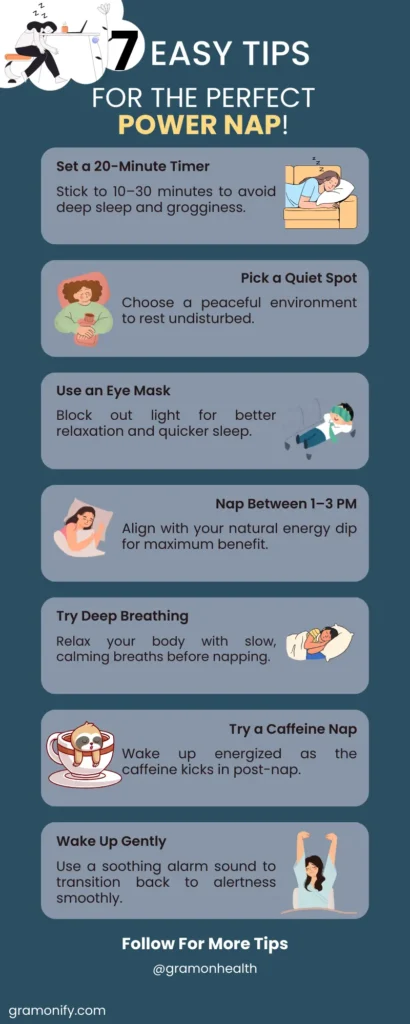Power naps can be a lifesaver, especially when you’re in the middle of a long study or work session. However, they can also backfire if you oversleep and wake up groggy, leaving you feeling worse than before. As someone who has spent countless afternoons trying to recharge without derailing my day, I’ve learned how to master the art of the power nap. Here’s a step-by-step guide to help you nap effectively, stay energized, and avoid the oversleeping trap.
The Science Behind Power Naps
Power naps are short, targeted naps that typically last between 10 to 30 minutes. They are designed to provide a quick energy boost, improve focus, and enhance mood. According to research from the National Sleep Foundation, power naps can improve cognitive function, reaction time, and memory retention.
Unlike longer naps, which can plunge you into the deeper stages of sleep, power naps keep you in the lighter stages. This prevents the grogginess, also known as sleep inertia, that often comes with waking from deep sleep. For me, understanding this distinction was key to making naps a productive part of my routine.
Why Power Naps Are Effective
Power naps work because they complement your body’s natural energy rhythms. In the early afternoon, many of us experience a natural dip in alertness—sometimes called the “post-lunch slump.” Taking a short nap during this time can recharge your batteries without interfering with your nighttime sleep. I’ve found that even a quick 15-minute rest can help me power through the rest of the day with renewed focus.
Step-by-Step Guide to Taking the Perfect Power Nap
If you’re ready to incorporate power naps into your routine, here are the steps I follow to ensure I wake up refreshed and not groggy:

1. Set a Timer
This is the single most important step. Decide how long you want to nap—between 10 and 30 minutes—and set an alarm. I’ve found that 20 minutes is my sweet spot because it’s long enough to rest but short enough to avoid entering deep sleep. Choose a gentle alarm sound to wake you up gradually without jarring you awake.
2. Choose the Right Environment
Your surroundings matter. Find a quiet, comfortable place where you won’t be disturbed. Use an eye mask to block out light and consider using earplugs or white noise to drown out distractions. I sometimes use a soft blanket for added comfort, but I avoid getting too cozy to prevent oversleeping.
3. Nap at the Right Time
Timing your nap is crucial. Napping too late in the day can disrupt your nighttime sleep, while napping too early may not provide the energy boost you need. I aim to nap between 1:00 PM and 3:00 PM, which aligns with my body’s natural dip in alertness.
4. Use Relaxation Techniques
Sometimes, falling asleep quickly can be a challenge. When this happens, I rely on relaxation techniques like deep breathing or progressive muscle relaxation. Even if I don’t fully fall asleep, these methods help me rest and recharge.
5. Try a Caffeine Nap
If you’re open to experimenting, a “caffeine nap” can be a game-changer. Drink a small cup of coffee or tea right before your nap. Since caffeine takes about 20 minutes to kick in, you’ll wake up feeling even more alert. I’ve used this trick on particularly busy days, and it works wonders.
Common Pitfalls and How to Avoid Them
While power naps are incredibly beneficial, they can go wrong if you’re not careful. Here are some common mistakes and how to avoid them:
- Oversleeping: Stick to your timer and avoid napping in bed, which can trick your brain into thinking it’s time for a full night’s sleep.
- Napping Too Late: Late-afternoon naps can interfere with your nighttime sleep schedule.
- Not Winding Down: If your mind is racing, take a few minutes to relax before attempting to nap.
Benefits of a Proper Power Nap
When done correctly, power naps offer a wide range of benefits:
- Enhanced Focus
After a well-timed nap, I often feel sharper and more productive, which helps me tackle complex tasks with ease. - Improved Mood
Napping can act as a reset button for your emotions, leaving you calmer and more balanced. - Increased Productivity
Short naps help combat fatigue, allowing me to maintain energy levels throughout the day. - Better Memory and Learning
Research from Harvard Medical School shows that napping can improve memory consolidation and learning. - Reduced Stress
Naps lower cortisol levels, the stress hormone, which helps me feel more relaxed and in control.
Alternatives to Power Naps
If napping isn’t feasible, there are other ways to recharge:
- Take a Walk: A brisk 10-minute walk can boost energy and improve focus.
- Hydrate: Drinking water can combat the fatigue caused by dehydration.
- Stretch: Simple stretches can increase circulation and relieve tension.
- Listen to Music: Uplifting or calming music can refresh your mind.
My Personal Experience
I wasn’t always a believer in naps. During college, I often felt too busy to rest and pushed through fatigue with coffee and willpower. But as I’ve gotten older, I’ve realized that short, intentional breaks can make all the difference. Now, I treat power naps as a non-negotiable part of my routine, especially during busy workdays or intense study sessions.
Final Thoughts
Power naps are a simple, effective way to recharge your mind and body. By setting a timer, choosing the right environment, and napping at the optimal time, you can enjoy all the benefits of rest without worrying about oversleeping. Remember, it’s not about the length of the nap but the quality. A 20-minute nap can provide a world of difference in how you feel and perform.
So, the next time you’re feeling drained, take a moment to power down. You’ll wake up refreshed, recharged, and ready to tackle whatever comes your way.